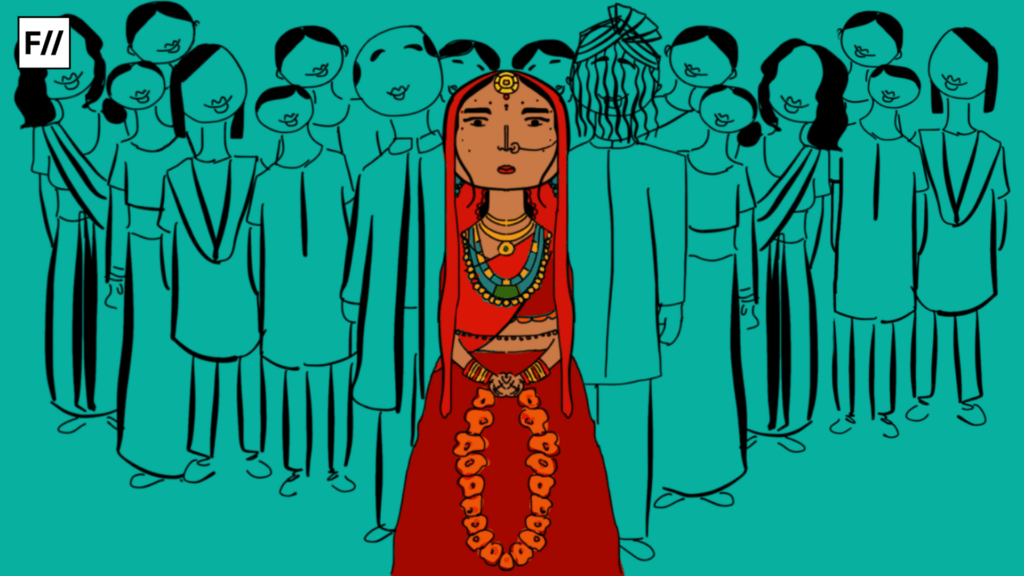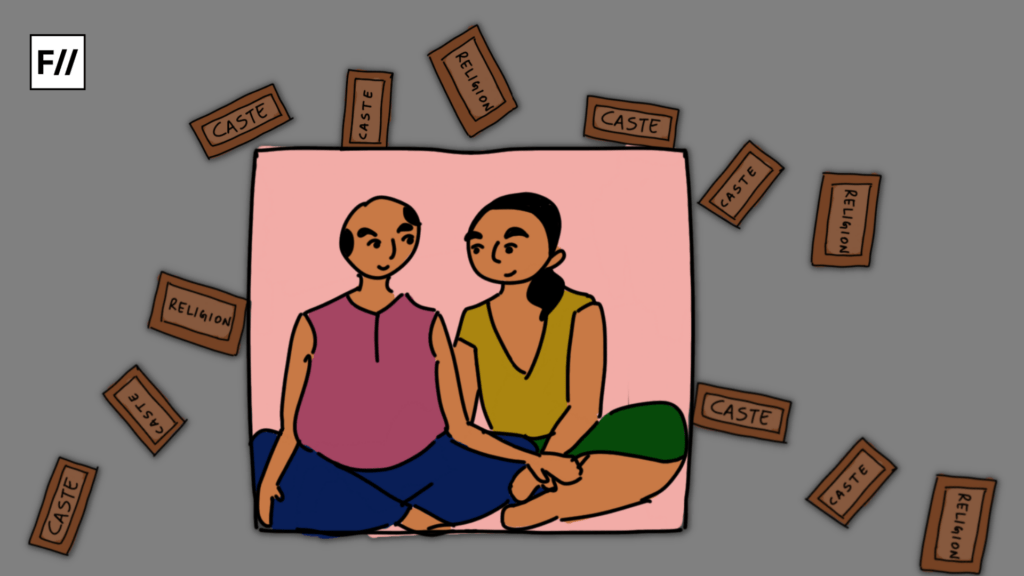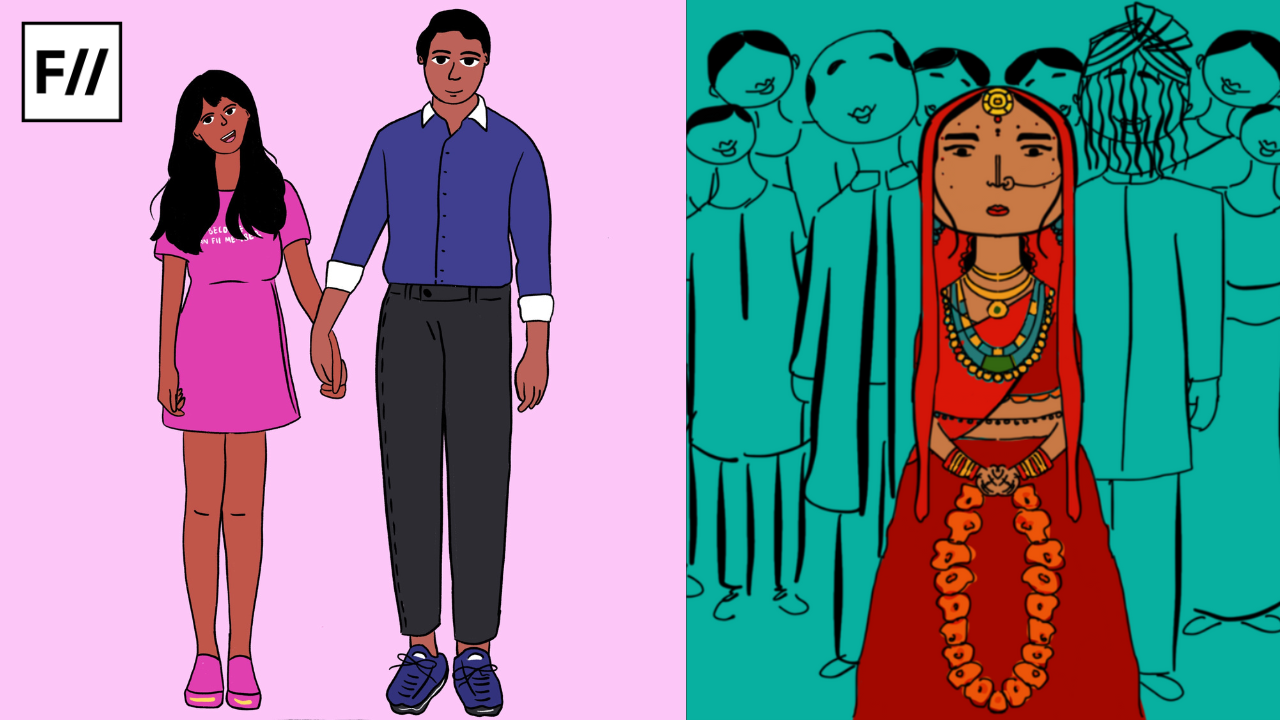Editor’s Note: FII’s #MoodOfTheMonth for February 2023 is Love In Post Modern India. We invite submissions on this theme throughout the month. If you would like to contribute, kindly refer to our submission guidelines and email your articles to shahinda@feminisminindia.com
All of us, at some point, experience love in one way or another. But, just because two people love each other, doesn’t mean they can live together. In common understanding, live-in relationships are probably the exact opposite of the institution of marriage. However, on closer inspection, one realises that live-in relationships and marriages are just two different ways of exploring love and living a life with someone you love. They have multiple intersections and divergences, this way, the choice is very subjective and perspective-based.
Marriage is a choice, and so is live-in. Before delving deeper into the two, one needs to understand the idea of marriage as an institution that we are talking about here is a voluntary choice. All arguments fail if this approach is forced, which is often the case with arranged marriages.
The first approach i.e. live-in comes from the fact that two people cannot just start a whole new life together without knowing how to live with each other, or whether or not they like this shared life. The second approach i.e. marriage on the other hand is based on the idea that we live in a society that has always followed certain systems, structures and institutions, marriage being one of them.
Also Read: Love At 55: Why Should Women Have The Choice To Find Love Again?
Marriage as an institution does not see romantic love just as it is. For it is instrumental in the creation of a family that is the functional unit of society. Therefore, a couple living together is just a part of a larger plan at play. This way, while live-in relationships see the love and living a life together as the end, for those who understand marriage as an institution, it is just a means to the ultimate end of a standard societal functioning.

Society, societal relationships and societal norms are very dynamic. Practices like polygamy that were popular and acceptable earlier are an aberration to society today. On the other hand, some practices were unacceptable previously which with time and the influence of diverse and foreign cultures and technological transformations have become a part and parcel of our normal lives. And with the notions of modernity coming in, there is greater acceptance of ideas like love marriage and live-in relationships.
In recent times, people are increasingly identifying marriages with compromise, an obligation to live in. One of the reasons for this could be when it is a forced choice due to traditional insistence. In fact, a survey shows that 26% of Indians, that too millennials, would prefer lifelong live-ins over marriages. As marriages involve more individuals than live-in relationships and a legal procedure so it becomes difficult to walk away from it. Therefore, there are more attempts at compromise involved.
Also Read: Looking for Love: A Deep Dive Into Arranged Heterosexual Marriages
One can understand this with the example of films like Thappad. Had there been less time, legal procedures, and emotional-mental trauma of not just two individuals involved in the relationship but also related people and no feelings like guilt, humiliation Etc felt, wouldn’t the protagonists be in a live-in relationship and not married? Many people would answer this question affirmatively. This side would say that, unlike marriage, a live-in relationship is not about “making it work“, it is about checking whether it works or not.
However, there is another section of people that would talk about how the time and legal efforts required for walking away just reinforce how important the relationship between these two people is not just for themselves but for society in general. They argue, what is wrong with putting in efforts to save a relationship if it works out in the end? These people also talk about how live-in relationships lack the security that one feels about one’s partner or about their relationship.

Live-in relationships lack a “social sanction” and thus, can reduce the accountability that one has towards one’s partner and reduces the check system that marriage as an institution has. One common example raised is, what if a live-in partner takes advantage of the other partner in for instance, monetary terms, sexually and emotionally and chooses to leave? If this happens in marriage, at least the other partner can ask for alimony legally. While prenuptial agreements can be made but they are not enforceable in any of the Indian courts.
Thus, when we look at both sides of the argument, they seem like two choices towards the same goal. Then, why is there a debate about live-in relationships as an “issue”? Well, it becomes an issue when one tries locating it in the larger history of how relationships have worked in India. Any new change or approach that is introduced in a society hitherto alien to the idea meets resistance.
Also Read: Love In India: Bridled Or Unbridled?
Looking at the case of love marriages, ancient scriptures identify Gandharv Vivah as an undesirable form of marriage. Love marriage can loosely be seen as its contemporary. Even over the course of centuries, the general societal conception was seeing love marriage as something objectionable. The justification ranged from pseudo-scientific ones like problems in the progeny as a result of Sagotra or same-caste marriage, which then even extended to people belonging to the same village. This is still the case for same-sex marriage.

In the 21st century, however, one can say that the situation has at least improved. Though instances of honour killing still crowd the headlines of newspapers, comparatively, love marriage has greater acceptance than it had earlier. While the matrimonial column in the newspapers still says things like looking for a “Marwadi” and “Hindu” girl, one has started seeing things like looking for a suitable groom from any caste as well. Increasing awareness about Queer rights is expected to improve the case for same-sex marriages as well. In a scenario like this, the resistance to live-in relationships does not come as a surprise.
Also Read: Moral Policing And Weaponisation Of Love
For centuries, marriage has not just been an institution of regulating the institution of the family but also regulating the sexuality of individuals. Having any sort of sexual relationship before marriage, therefore, is associated with the virtue of an individual. The idea of live-in relationships cuts at the root of this notion. Therefore, it has been opposed by many, especially those from theocratic circles and groups, individuals opposing the idea of consummating a relationship before marriage.
Going to the other side, consider this example- those actively checking reels on Instagram must have seen this trend- I like the idea of arranged marriage, but what if he/she/they like Pineapple toppings on Pizza (basically something that the other person doesn’t like). This very trend highlights why some people, especially the youth, prefer live-in relationships over marriage. For them, it is a way of seeing if they can adjust to each other’s habits, choices, and likes-dislikes without much compromise on their part and even seeing how this affects their romantic, emotional and sexual relationship. They reject the claim that this is just a way for them to avoid responsibility as they are committed and serious about it, but, if it does not work out, then, they can move on with fewer procedures, individuals and parties being involved.

Therefore, if located in the Indian context, a Live-in relationship is not just a concept, it is a debate. On the one hand, it is seen as a stark marker of increasing acceptance of western culture, not being Sanskari or cultured, a way for youth to just fool around and avoid responsibility; on the other hand, it is seen as an opportunity to ensure whether two people are actually compatible to live together and a way of expressing the freedom of choice. Over time, some have perceived this debate as something associated with the generation gap rather than being a stand-alone issue. This generation gap has perhaps been covered when it comes to the issue of love marriage as statistics show that 62.3% of Millennials and 69.2% of Gen Zs prefer love marriages over arranged ones.
All in all, claiming either of these choices as “the correct one” or “the best one” would be unfair but saying that this way is “best for me” is not wrong. Live-in relationships and marriages are just two different approaches to exploring and expressing love and the choice of either cannot and should not be questioned or judged.
About the author(s)
Arya is an undergraduate student pursuing an Integrated Master's in Development Studies from the Indian Institute of Technology, Chennai. She completed her schooling in the humanities stream from Nagpur. Still hooked to teenage novels, she likes singing, dancing and loves talking. Intersectionality became her favourite word since the time she was introduced to it. Her major interests include adopting the intersectional feminist approach in studying other disciplines like Economics, Management, Development and interpretation of literature, films Etc.







False cases of dowry, alimony, child support, extortion of lakhs of rupees, women running away with children after a divorce are just a few reasons why men don’t want to get married today. No need for drama and chaos and the risk of losing money and peace of mind.